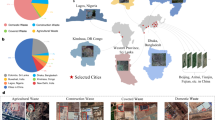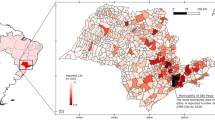Abstract
Enforcement of environmental law depends critically on permitting and monitoring intensive animal agricultural facilities, known in the United States as ‘concentrated animal feeding operations’ (CAFOs). The current legal landscape in the United States has made it difficult for government agencies, environmental groups and the public to know where such facilities are located. Numerous groups have, as a result, conducted manual, resource-intensive enumerations based on maps or ground investigation to identify facilities. Here we show that applying a deep convolutional neural network to high-resolution satellite images offers an effective, highly accurate and lower cost approach to detecting CAFO locations. In North Carolina, the algorithm is able to detect 589 additional poultry CAFOs, representing an increase of 15% from the baseline that was detected through manual enumeration. We show how the approach scales over geography and time, and can inform compliance and monitoring priorities.
This is a preview of subscription content, access via your institution
Access options
Access Nature and 54 other Nature Portfolio journals
Get Nature+, our best-value online-access subscription
$29.99 / 30 days
cancel any time
Subscribe to this journal
Receive 12 digital issues and online access to articles
$119.00 per year
only $9.92 per issue
Buy this article
- Purchase on Springer Link
- Instant access to full article PDF
Prices may be subject to local taxes which are calculated during checkout





Similar content being viewed by others
Data availability
The replication code and datasets generated during the current study are available in the GitHub repository github.com/slnader/cafo_public.
References
Dimitri, C., Effland, A. & Conklin, N. The 20th Century Transformation of U.S. Agriculture and Farm Policy Economic Information Bulletin 3 (USDA, 2005).
Copeland, C. Animal Waste and Water Quality: EPA Regulation of Concentrated Animal Feeding Operations (CAFOs) Technical Report No. CRS-RL31851 (Congressional Research Service, 2010).
40 C.F.R. 122.23 - Concentrated Animal Feeding Operations (Applicable to State NPDES Programs) (Environmental Protection Agency, 2011); https://www.govinfo.gov/app/details/CFR-2011-title40-vol22/CFR-2011-title40-vol22-sec122-23
Casey, J. A., Kim, B. F., Larsen, J., Price, L. B. & Nachman, K. E. Industrial food animal production and community health. Curr. Environ. Health Rep. 2, 259–271 (2015).
Hribar, C. Understanding Concentrated Animal Feeding Operations and Their Impact on Communities (National Association of Local Boards of Health, 2010).
Environmental Protection Agency National pollutant discharge elimination system permit regulation and effluent limitation guidelines and standards for concentrated animal feeding operations (CAFOs). Fed. Regist. 68, 7176–7274 (2003).
Rogers, S. & Haines, J. Detecting and Mitigating the Environmental Impact of Fecal Pathogens Originating from Confined Animal Feeding Operations (EPA, 2005).
Graham, J. P. & Nachman, K. E. Managing waste from confined animal feeding operations in the United States: the need for sanitary reform. J. Water Health 8, 646–670 (2010).
Conerly, O. & Vazquez Coriano, L. Literature Review of Contaminants in Livestock and Poultry Manure and Implications for Water Quality Report No. EPA 820-R-13-002 (EPA, 2013).
Waterkeeper v. EPA [2005] 399 F.3d 486 (2d Cir. 2005).
Nat’l Pork Producers Council v. EPA [2011] 635 F.3d 738 (5th Cir. 2011).
Environmental Protection Agency National pollutant discharge elimination system (NPDES) concentrated animal feeding operation (CAFO) reporting rule. Fed. Regist. 76, 65431–65458 (2011).
Concentrated Animal Feeding Operations: EPA Needs More Information and A Clearly Defined Strategy to Protect Air and Water Quality from Pollutants of Concern Technical Report No. GAO-08-944 (US Government Accountability Office, 2008).
Environmental Protection Agency National pollutant discharge elimination system (NPDES) concentrated animal feeding operation (CAFO) reporting rule. Fed. Regist. 77, 42679–42682 (2012).
American Farm Bureau Fed. v. EPA [2016] 836 F.3d 963 (8th Cir. 2016).
Brown, C. R. Uncooperative federalism, misguided textualism: the federal courts’ mistaken hostility toward pre-discharge regulation of confined animal feeding operations under the clean water act. Temple J. Sci. Technol. Environ. Law 30, 175–219 (2011).
Jerger, S. EPA’s new CAFO land application requirements: an exercise in unsupervised self-monitoring. Stanf. Environ. Law J. 23, 91–130 (2004).
Moses, A. & Tomaselli, P. in International Farm Animal, Wildlife and Food Safety Law (eds Steier, G. & Patel, K.) 185–214 (Springer, 2017).
Pew Commission on Industrial Farm Animal Production Putting Meat on the Table: Industrial Farm Animal Production in America (Pew Charitable Trusts and Johns Hopkins Bloomberg School of Public Health, 2007).
Peterka, A. Enviro groups return CAFO data at heart of Hill probes. E&E Daily https://www.eenews.net/stories/1059979265/print (11 April 2013).
Formuzis, A. Fields of filth: landmark report maps feces-laden hog and chicken operations in North Carolina. Environmental Working Group https://www.ewg.org/release/fields-filth-landmark-report-maps-feces-laden-hog-and-chicken-operations-north-carolina (22 June 2016).
Factory Farm Nation 2015 Edition (Food & Water Watch, 2015); https://www.factoryfarmmap.org/wp-content/uploads/2015/05/FoodandWaterWatchFactoryFarmFinalReportNationMay2015.pdf
Stopping CAFO Pollution (Michigan Chapter, Sierra Club, 2018); https://www.sierraclub.org/michigan/stopping-cafo-pollution
Complaint Under Title VI of the Civil Rights Act of 1964 (EarthJustice, 2014); https://go.nature.com/2VRyw15
2017 Annual Report for Work Plan Agreement Between the Iowa Department of Natural Resources and the Environmental Protection Agency Region 7 (Iowa Department of Natural Resources, 2017).
Kamilaris, A. & Prenafeta-Boldú, F. X. Deep learning in agriculture: a survey. Comput. Electron. Agric. 147, 70–90 (2018).
Osburn, C. L., Handsel, L. T., Peirels, B. L. & Paerl, H. W. Predicting source of dissolved organic nitrogen to an estuary from an agro-urban coastal watershed. Environ. Sci. Technol. 50, 8473–8484 (2016).
Patt, H. A Comparison of PAN and P 2 O 5 Produced from Poultry, Swine and Cattle Operations in North Carolina (Division of Water Resources, North Carolina Department of Environmental Quality, 2017); https://go.nature.com/2NWY3Df
Ilea, R. C. Intensive livestock farming: global trends, increased environmental concerns, and ethical solutions. J. Agric. Environ. Ethics 22, 153–167 (2009).
Saito, T. & Rehmsmeier, M. The precision-recall plot is more informative than the ROC plot when evaluating binary classifiers on imbalanced datasets. PLoS ONE 10, e0118432(2015).
Zhou, B., Khosla, A., Lapedriza, A., Oliva, A. & Torralba, A. Learning deep features for discriminative localization. In IEEE Conference on Computer Vision and Pattern Recognition 2921–2929 (IEEE, 2016).
Amstrup, S. C., McDonald, T. L. & Manly, B. F. Handbook of Capture–Recapture Analysis (Princeton Univ. Press, 2010).
Hurst, N. How daily images of the entire Earth will change the way we look at it. Smithsonian https://www.smithsonianmag.com/innovation/how-daily-images-entire-earth-will-change-way-we-look-it-180962467/ (13 March 2017).
MacDonald, J. M. et al. Contracts, Markets, and Prices: Organizing the Production and Use of Agricultural Commodities Agricultural Economic Report No. aer-837 (US Department of Agriculture, 2004).
McVey, M. J. et al. Identifying an efficient feed distribution system in the Midwest. In SAEA 2003 Annual Meeting https://go.nature.com/2Cece28 (Southern Agricultural Economics Association, 2003).
Newcombe, T. Is government ready for AI? Government Technology http://www.govtech.com/products/Is-Government-Ready-for-AI.html (1 July 2018).
Walton, B. EPA turns away from CAFO water pollution. Circle of Blue https://www.circleofblue.org/2016/water-policy-politics/epa-turns-away-cafo-water-pollution/ (2016).
Branson, S. et al. Visual recognition with humans in the loop. In European Conference on Computer Vision Vol. 6314 (eds Daniilidis, K. et al.) 438–451 (Springer, 2010).
Scoles, S. 88 new satellites will watch Earth, all the time, all the places. Wired https://www.wired.com/2017/02/88-tiny-satellites-will-watch-time-everywhere/ (14 February 2017).
What are the technical specifications for Google Imagery? (Google, 2018); https://support.google.com/mapsdata/answer/6261838?hl=en
Russakovsky, O. et al. ImageNet large scale visual recognition challenge. Int. J. Comput. Vision 115, 211–252 (2014).
Simonyan, K. & Zisserman, A. Very deep convolutional networks for large-scale image recognition. In 3rd International Conference on Learning Representations https://go.nature.com/2TwYLwN (Computational and Biological Learning Society, 2014).
Szegedy, C., Vanhoucke, V., Ioffe, S., Shlens, J. & Wojna, Z. Rethinking the inception architecture for computer vision. In IEEE Conference on Computer Vision and Pattern Recognition 2818–2826 (IEEE, 2016).
Oquab, M., Bottou, L., Laptev, I. & Sivic, J. Learning and transferring mid-level image representations using convolutional neural networks. In IEEE Conference on Computer Vision and Pattern Recognition 1717–1724 (IEEE, 2014).
Simard, P. Y., Steinkraus, D. & Platt, J. C. Best practices for convolutional neural networks applied to visual document analysis. 7th International Conference on Document Analysis and Recognition. Institute of Electrical and Electronics Engineers. 958-962 (2003).
Krizhevsky, A., Sutskever, I. & Hinton, G. E. ImageNet classification with deep convolutional neural networks. In Advances in Neural Information Processing Systems Vol. 25 (eds Pereira, F. et al.) 1097–1105 (ACM, 2012).
Srivastava, N., Hinton, G., Krizhevsky, A., Sutskever, I. & Salakhutdinov, R. Dropout: a simple way to prevent neural networks from overfitting. J. Mach. Learn. Res. 15, 1929–1958 (2014).
Buda, M., Maki, A. & Mazurowski, M. A. A systematic study of the class imbalance problem in convolutional neural networks. Neural Netw. 106, 249–259 (2018).
Mazurowski, M. A. et al. Training neural network classifiers for medical decision making: the effects of imbalanced datasets on classification performance. Neural Netw. 21, 427–436 (2008).
Smith, L. N. Cyclical learning rates for training neural networks. 2017 IEEE Winter Conference on Applications of Computer Vision. Institute of Electrical and Electronics Engineers. 464-472 (2017).
Acknowledgements
We thank Z. Ashwood, G. Hong, C. Hull and A. Teuscher for research assistance, the Environmental Working Group for sharing data, Descartes Labs and Google Earth Engine for providing access to their research platform, the GRACE Communications Foundation and the Stanford Institute for Economic and Policy Research for generous support, and C. Cox, B. Erden, S. A. C. Gomez, M. Hancher, M. Engelman Lado, J. Lee, P. Lehner, D. Lobell, J. Quinlivan, S. Rundquist, D. Sivas and the participants of the Data for Sustainable Development class at Stanford University for helpful conversations.
Author information
Authors and Affiliations
Contributions
C.H.-N. and D.E.H. jointly designed the study, collected data, developed the methods, performed the analysis and wrote the manuscript.
Corresponding author
Ethics declarations
Competing interests
The authors declare no competing interests.
Additional information
Publisher’s note: Springer Nature remains neutral with regard to jurisdictional claims in published maps and institutional affiliations.
Supplementary information
Supplementary information for deep learning to map concentrated animal feeding operations
26 pages with suppl. notes, discussion, figures, tables and references
Rights and permissions
About this article
Cite this article
Handan-Nader, C., Ho, D.E. Deep learning to map concentrated animal feeding operations. Nat Sustain 2, 298–306 (2019). https://doi.org/10.1038/s41893-019-0246-x
Received:
Accepted:
Published:
Issue Date:
DOI: https://doi.org/10.1038/s41893-019-0246-x
This article is cited by
-
Revealing influencing factors on global waste distribution via deep-learning based dumpsite detection from satellite imagery
Nature Communications (2023)
-
Reconstructing the historical expansion of industrial swine production from Landsat imagery
Scientific Reports (2022)
-
Metagenomic characterization of swine slurry in a North American swine farm operation
Scientific Reports (2021)
-
Automated recognition of postures and drinking behaviour for the detection of compromised health in pigs
Scientific Reports (2020)
-
From hogs to HABs: impacts of industrial farming in the US on nitrogen and phosphorus and greenhouse gas pollution
Biogeochemistry (2020)



